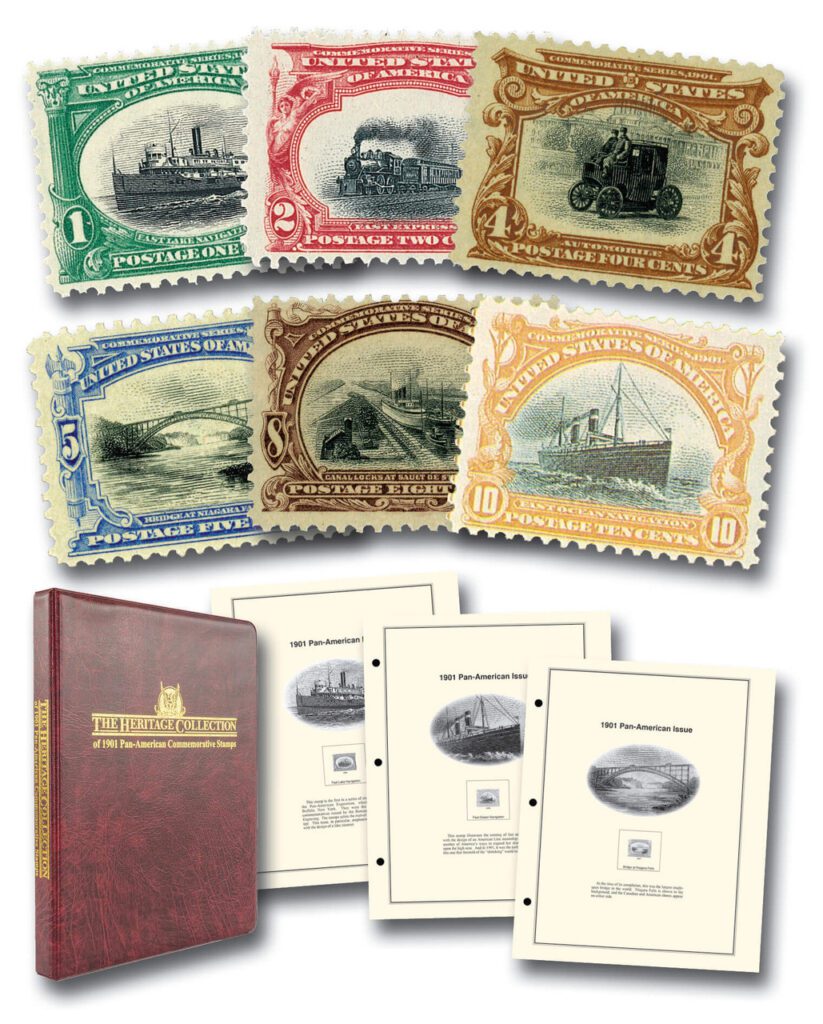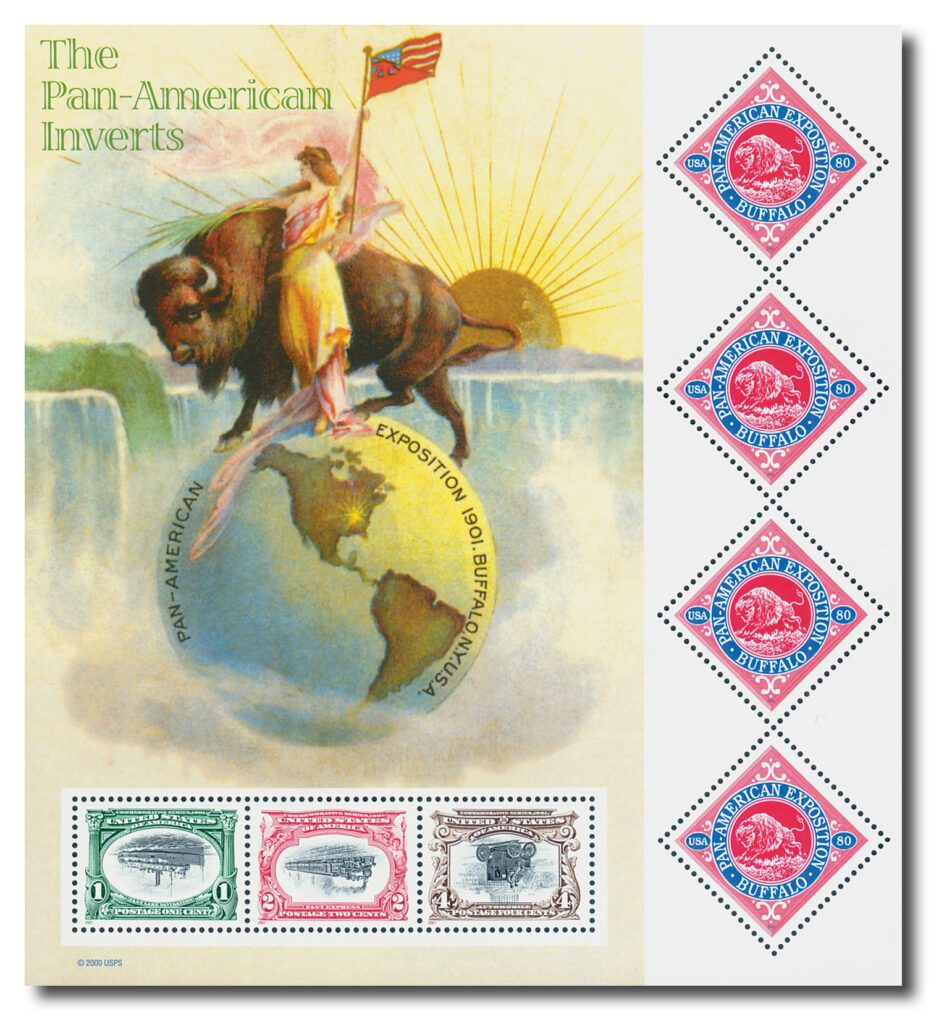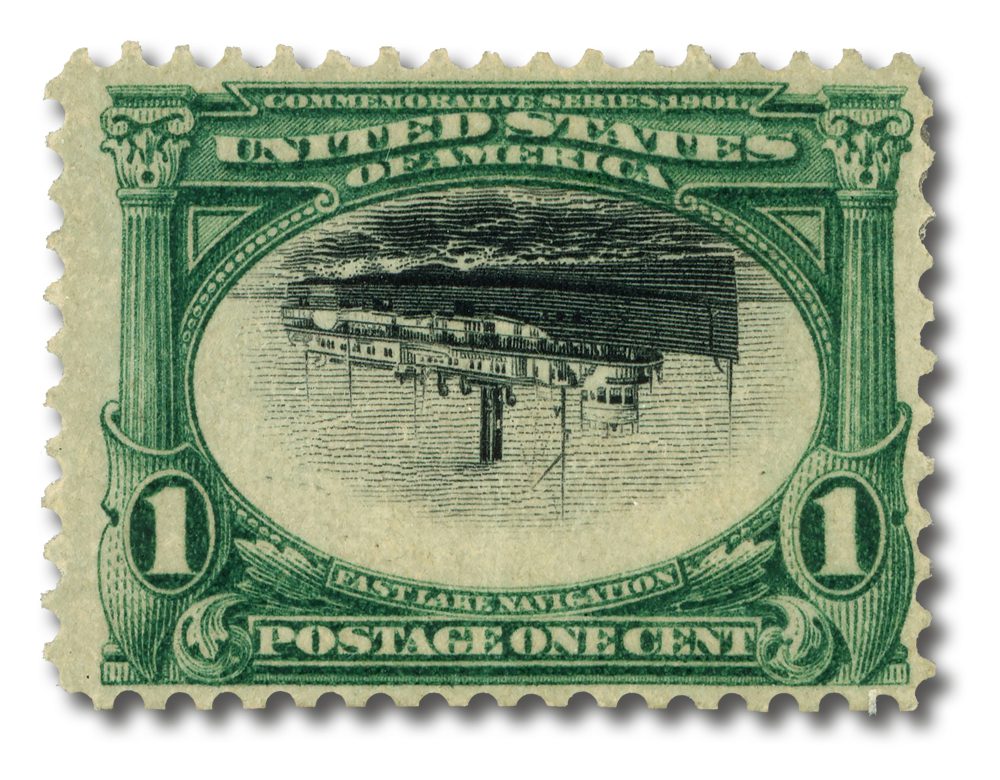The Pan-American Inverts
The Pan-American Inverts are among the most storied and coveted errors in US philately. They capture both the drama of early 20th-century printing and the excitement of the Pan-American Exposition of 1901.

Comes with a FREE album and mounts!
The Pan-American Exposition and Its Stamps
The Pan-American Exposition, held in Buffalo, New York, from May 1 to November 2, 1901, was a grand showcase of industrial and technological progress. To commemorate the event, the US Post Office issued six bi-colored stamps, each featuring a black-and-white vignette of modern transportation framed by an ornate colored border. These were the first bi-colored commemoratives of the 20th century, and their production required two separate printings—one for the vignette and one for the frame.
How the Inverts Happened
The two-step printing process made these stamps vulnerable to errors. If a sheet was fed into the press backwards for the second pass, the frame would be printed upside down relative to the vignette, creating an “invert” error. This is exactly what happened with three denominations: the 1¢, 2¢, and 4¢ stamps. The inverts are a direct result of the complex, bi-color printing process, making each a tangible piece of printing history.
The 1¢ Fast Lake Navigation Invert
US #294a features the steamer City of Alpena, a symbol of fast lake navigation, with its central image mistakenly inverted. This error was discovered in at least four post offices soon after the stamps were released. The first known examples were found in Bessemer, Alabama, by the Carrell Jewelry Company. The company realized the significance of the find and quickly salvaged the stamps from circulars. Only ten sheets were discovered, so fewer than 1,000 are available to collectors.
The 2¢ Fast Express Invert
This stamp shows the Empire State Express train, which was operated by the New York Central and Hudson Railroad. As the train ran from New York City to Buffalo, many of the fairgoers likely rode it to reach the exposition. The 2¢ invert is actually the rarest of the Pan-American inverts. Only two sheets of these errors are believed to have been issued through post offices.
The 4¢ Automobile Invert
Many of the first cars developed were electric, like the one shown on the 4¢ Pan-American stamp. The automobile is a closed coach model, and part of the United States Capitol building can be seen in the back. The 4¢ invert differs from the rest in that it was never actually issued through post offices. When the Post Office Department received a mistaken report that a 4¢ invert had been discovered, it requested four sheets be printed for specimen purposes. While some had “Specimen” hand-stamped on them, many did not. Additionally, a sheet of 100 was kept by the Post Office Department, before being broken up a little over 15 years later. 97 copies from that sheet exchanged for other materials missing from the governments collection.
About the Exposition
Running from May 1 through November 2, the exposition spanned 342 acres. One of its major features was the use of electric lighting, created by hydroelectric power from nearby Niagara Falls. Additionally, many companies offered “working exhibits” that not only informed visitors, but also helped the exposition to function. Some of the new inventions on display included the electrograph, telautograph, voting machine, mutoscopes, a mechanical mowing machine, a typesetting machine, and an envelope-making machine.
The Exposition was also an effort to promote better relations between North and South America. America’s 25th president, William McKinley, gave one of the most important speeches of his presidency when he announced a change in his high-tariff isolationist trade policies. “…by sensible trade relations which will not interrupt our home production, we shall extend the outlets of our increasing surplus… The period of exclusiveness is past.”
Unfortunately, the events of the Pan-American Exposition took a sad turn on September 6, 1901. The day after giving his speech, President McKinley held a public reception at the Exposition’s Temple of Music. As the president shook hands with members of a large crowd that had gathered to meet him, Leon F. Czogosz extended his arm to the president and fired two shots from a pistol concealed under a handkerchief. Although one of the bullets only grazed McKinley, the second hit him squarely in the abdomen. Despite signs of recovery, President McKinley passed away on September 14, 1901. Vice President Theodore Roosevelt took the oath of office and became president. Czogosz was later executed for his crime.

This pane of stamps reproduces the three original inverts alongside commemorative “cinderella” stamps inspired by the exposition.
A Piece of American History
The Pan American Inverts are more than just postage errors—they represent a pivotal moment in American industrial history and the dawn of the 20th century. Their story intertwines the excitement of a world’s fair, the challenges of early stamp production, and the thrill of discovery. For collectors, they are prized artifacts of American history, innovation, and the enduring allure of the unexpected.


